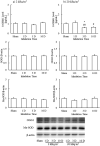Radon inhalation decreases DNA damage induced by oxidative stress in mouse organs via the activation of antioxidative functions
- PMID: 34370027
- PMCID: PMC8438471
- DOI: 10.1093/jrr/rrab069
Radon inhalation decreases DNA damage induced by oxidative stress in mouse organs via the activation of antioxidative functions
Abstract
Radon inhalation decreases the level of lipid peroxide (LPO); this is attributed to the activation of antioxidative functions. This activation contributes to the beneficial effects of radon therapy, but there are no studies on the risks of radon therapy, such as DNA damage. We evaluated the effect of radon inhalation on DNA damage caused by oxidative stress and explored the underlying mechanisms. Mice were exposed to radon inhalation at concentrations of 2 or 20 kBq/m3 (for one, three, or 10 days). The 8-hydroxy-2'-deoxyguanosine (8-OHdG) levels decreased in the brains of mice that inhaled 20 kBq/m3 radon for three days and in the kidneys of mice that inhaled 2 or 20 kBq/m3 radon for one, three or 10 days. The 8-OHdG levels in the small intestine decreased by approximately 20-40% (2 kBq/m3 for three days or 20 kBq/m3 for one, three or 10 days), but there were no significant differences in the 8-OHdG levels between mice that inhaled a sham treatment and those that inhaled radon. There was no significant change in the levels of 8-oxoguanine DNA glycosylase, which plays an important role in DNA repair. However, the level of Mn-superoxide dismutase (SOD) increased by 15-60% and 15-45% in the small intestine and kidney, respectively, following radon inhalation. These results suggest that Mn-SOD probably plays an important role in the inhibition of oxidative DNA damage.
Keywords: 8-oxoguanine DNA glycosylase; Mn-superoxide dismutase (SOD); oxidative DNA damage; radon.
© The Author(s) 2021. Published by Oxford University Press on behalf of The Japanese Radiation Research Society and Japanese Society for Radiation Oncology.
Figures



References
-
- Lange U, Dischereit G, Tarner I et al. The impact of serial radon and hyperthermia exposure in a therapeutic adit on pivotal cytokines of bone metabolism in rheumatoid arthritis and osteoarthritis. Clin Rheumatol 2016;35:2783–8. - PubMed
-
- Yamaoka K, Mitsunobu F, Hanamoto K et al. Study on biologic effects of radon and thermal therapy on osteoarthritis. J Pain 2004;5:20–5. - PubMed
-
- Franke A, Reiner L, Pratzel HG et al. Long-term efficacy of radon spa therapy in rheumatoid arthritis—A randomized, sham-controlled study and follow-up. Rheumatol 2000;39:894–902. - PubMed
-
- Franke A, Reiner L, Resch KL. Long-term benefit of radon spa therapy in the rehabilitation of rheumatoid arthritis: a randomised, double-blinded trial. Rheumatol Int 2007;27:703–13. - PubMed
-
- Moder A, Hufnagl C, Lind-Albrecht G et al. Effect of combined Low-Dose Radon-and Hyperthermia Treatment (LDRnHT) of patients with ankylosing spondylitis on serum levels of cytokines and bone metabolism markers: a pilot study. Int J Low Radiat 2010;7:423–35.
Publication types
MeSH terms
Substances
Grants and funding
LinkOut - more resources
Full Text Sources
Medical
Research Materials

